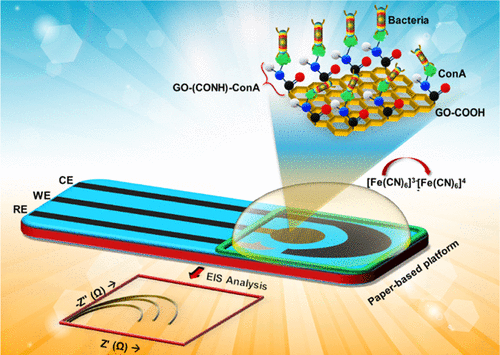Our official English website, www.x-mol.net, welcomes your feedback! (Note: you will need to create a separate account there.)
Ultrasensitive and Low-Cost Paper-Based Graphene Oxide Nanobiosensor for Monitoring Water-Borne Bacterial Contamination
ACS Sensors ( IF 8.9 ) Pub Date : 2021-08-30 , DOI: 10.1021/acssensors.1c00851 Stalin Karuppiah, Narayan Chandra Mishra, Wei-Chen Tsai, Wei-Ssu Liao, Chia-Fu Chou
ACS Sensors ( IF 8.9 ) Pub Date : 2021-08-30 , DOI: 10.1021/acssensors.1c00851 Stalin Karuppiah, Narayan Chandra Mishra, Wei-Chen Tsai, Wei-Ssu Liao, Chia-Fu Chou

|
Water-borne pathogens are mostly generated due to poor sanitation, industrial effluents, and sewage sludge, leading to a significant increase in mortality rate. To prevent this, we need a simple, user-friendly, and rapid on-site detection tool of pathogens, i.e., a biosensor. As contaminated water mainly contains (80%) coliform bacteria, of which Escherichia coli is the major species, we have developed a screen-printed paper-based, label-free biosensor for the detection of E. coli in water. A nanoarchitectured graphene oxide (GO), as a fast electron-transfer flatland, was deposited on the screen-printed graphene (G) on a hydrophobic paper, followed by the immobilization of lectin Concanavalin A (ConA) as a biorecognition element for a GGO_ConA-biosensing electrode. The electrochemical characterization of GGO_ConA shows fast electron transfer with a calculated electroactive surface area of 0.16 cm2. The biosensor performance was tested in the sludge water and beach water (real sample) as an analyte using the electrochemical impedance spectroscopy (EIS) technique. The charge-transfer resistance (Rct) of GGO_ConA increases linearly with the bacterial concentration in the range of 10–108 CFU mL–1 with an estimated limit of detection (LOD) of 10 CFU mL–1, which indicates the ultrasensitivity of our biosensor, with 100 times more sensitivity than previous studies. Our reported biosensor, being cost-effective, eco-friendly, and ultrasensitive, may serve greatly as a portable monitoring kit for checking water-borne bacterial contamination.
中文翻译:

用于监测水生细菌污染的超灵敏、低成本纸质氧化石墨烯纳米生物传感器
水源性病原体主要是由于卫生条件差、工业废水和污水污泥而产生,导致死亡率显着增加。为了防止这种情况发生,我们需要一种简单、用户友好且快速的现场病原体检测工具,即生物传感器。由于受污染的水主要含有 (80%) 大肠菌群,其中大肠杆菌是主要种类,我们开发了一种基于丝网印刷的纸质无标签生物传感器,用于检测大肠杆菌在水里。将纳米结构的氧化石墨烯 (GO) 作为快速电子转移平面沉积在疏水纸上的丝网印刷石墨烯 (G) 上,然后固定凝集素伴刀豆球蛋白 A (ConA) 作为 GGO_ConA 的生物识别元件-生物传感电极。GGO_ConA 的电化学表征显示出快速电子转移,计算出的电活性表面积为 0.16 cm 2。使用电化学阻抗谱 (EIS) 技术在作为分析物的污泥水和海滩水(真实样品)中测试生物传感器的性能。GGO_ConA的电荷转移电阻 ( R ct ) 在 10–10 8 CFU mL –1范围内随细菌浓度线性增加估计检测限 (LOD) 为 10 CFU mL –1,这表明我们的生物传感器具有超灵敏性,其灵敏度是之前研究的 100 倍。我们报道的生物传感器具有成本效益、环保和超灵敏的特点,可以作为一种便携式监测工具,用于检查水传播的细菌污染。
更新日期:2021-09-24
中文翻译:

用于监测水生细菌污染的超灵敏、低成本纸质氧化石墨烯纳米生物传感器
水源性病原体主要是由于卫生条件差、工业废水和污水污泥而产生,导致死亡率显着增加。为了防止这种情况发生,我们需要一种简单、用户友好且快速的现场病原体检测工具,即生物传感器。由于受污染的水主要含有 (80%) 大肠菌群,其中大肠杆菌是主要种类,我们开发了一种基于丝网印刷的纸质无标签生物传感器,用于检测大肠杆菌在水里。将纳米结构的氧化石墨烯 (GO) 作为快速电子转移平面沉积在疏水纸上的丝网印刷石墨烯 (G) 上,然后固定凝集素伴刀豆球蛋白 A (ConA) 作为 GGO_ConA 的生物识别元件-生物传感电极。GGO_ConA 的电化学表征显示出快速电子转移,计算出的电活性表面积为 0.16 cm 2。使用电化学阻抗谱 (EIS) 技术在作为分析物的污泥水和海滩水(真实样品)中测试生物传感器的性能。GGO_ConA的电荷转移电阻 ( R ct ) 在 10–10 8 CFU mL –1范围内随细菌浓度线性增加估计检测限 (LOD) 为 10 CFU mL –1,这表明我们的生物传感器具有超灵敏性,其灵敏度是之前研究的 100 倍。我们报道的生物传感器具有成本效益、环保和超灵敏的特点,可以作为一种便携式监测工具,用于检查水传播的细菌污染。


























 京公网安备 11010802027423号
京公网安备 11010802027423号